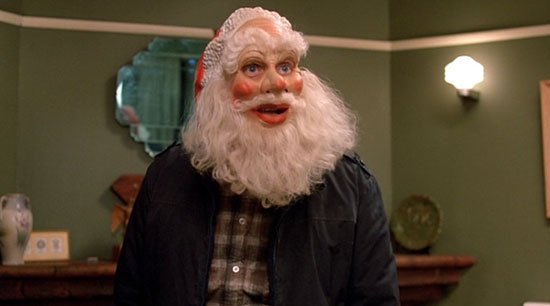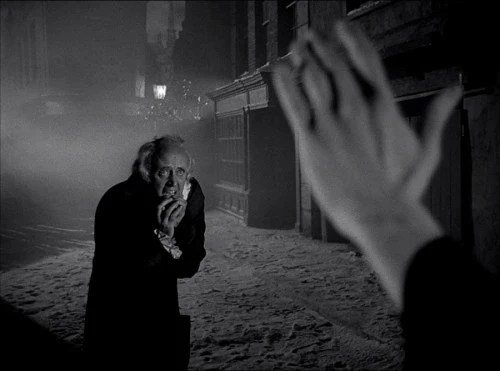The title of this post is a line from a famous Christmas song that you undoubtedly have heard (maybe too much?) yet again this year..
Andy Williams’ classic IT’S THE MOST WONDERFUL TIME OF YEAR has a series of nostalgic verses about the season our calenders currently inhabit.. The most wonderful time of year, he concludes with his melody.. But that one line, that ‘scary ghost stories’ reference, has often been overlooked and ignored..
Some may think Williams is talking about Charles Dickens and his CHRISTMAS CAROL, Scrooge’s ghosts of the past present and future coming to haunt in the dead of night..
But the story goes much deeper. That one line in a song lyric has much more meaning for the season than anyone really understands.

On this website, I talked a lot about Krampus, that pesky demonic figure who scares the goodness into kids this time of year. This year he's the star of a movie. And we also focused on those scary ghost stories..
For those who think the paranormal notions take a break after Halloween winds down, think again.. It just begins. And Christmas was the season of high strangeness, spooky occurrences, and bumps in the night that could not be attributed to elves or Santa’s quest to find a chimney..
It's pagan origins--the Yule log, the evergreen, the lit candle in a window--are all documented. Santa and Krampus used to travel as good cop and bad cop.. Even before Fox News declared that there is a 'war on Christmas,' many puritans in America did not even want Christmas to be celebrated. They did not like burning human sacrifices .. they did not log the phallic image of the Yule log. They did not appreciate fearing the ghosts of the night as winter's brutal chill set in...
But as time went on, the Puritans lost. Some may say the pagans eventually won, despite the Nativity scene and idea that Christmas is the time to celebrate Christ's birthday, most of the 'bad' stuff from the pre Catholic era stuck around.
Roger Clarke authored a book titled A NATURAL HISTORY OF GHOSTS: 500 YEARS OF HUNTING FOR PROOF.. He detailed why the Victorian age became the prime time for paranormal tales to be woven by people around the holiday season..
The UK GUARDIAN’s Kim Cochrane explained this in a 2013 article profiling Clarke’s book:
The popularity of ghost stories was strongly related to economic changes. The industrial revolution had led people to migrate from rural villages into towns and cities, and created a new middle class. They moved into houses that often had servants, says Clarke, many taken on around October or November, when the nights were drawing in early – and new staff found themselves “in a completely foreign house, seeing things everywhere, jumping at every creak”. Robbins says servants were “expected to be seen and not heard – actually, probably not even seen, to be honest. If you go to a stately home like Harewood House, you see the concealed doorways and servant’s corridors. You would actually have people popping in and out without you really knowing they were there, which could be quite a freaky experience. You’ve got these ghostly figures who actually inhabit the house.”The fondness of telling ghost stories around warm December fires also struck another author, one from a longer time ago.. Jerome K. Jerome said this in his book TALES AFTER SUPPER in 1891:
Whenever five or six English-speaking people meet round a fire on Christmas Eve, they start telling each other ghost stories. Nothing satisfies us on Christmas Eve but to hear each other tell authentic anecdotes about specters.The idea of ghost stories was common–very common as a matter of fact.. the relics of that time still haunt, to a degree. But any memory has been tamed and watered down through the ages..
And think of this: Even if you keep the Christ in Christmas, that is paranormal just in itself.. Imagine the notion of a woman going about business, being told by an entity from beyond this world that she will give birth to a paranormal savior who will eventually die but rise from the dead and open the door to another realm.. If you believe in the Christian idea of Christmas, you must conclude that you wholeheartedly have faith in the paranormal and believe in it..

The veil is thin on Christmas.. as a matter of fact, some mystics through the ages have cited Christmas, not All Souls’ Day or any other time, as the prime time moment for the thinnest of the veil.Even a 19th century nun named Saint Teresa of Avila stated just that..
The Victorian age was in itself quite scary–the problems which manifested themselves often went unexplained. Science was beginning to explain some, but not all events.. Those shadows Clarke described were common.. The ghost tales that Jerome wrote about were frightening. Krampus would also show up from time to time, beating children with a stick for unruly behavior throughout the year..
Christmas has long been associated with ghosts, says Roger Clarke, author of A Natural History of Ghosts: 500 Years of Hunting for Proof. Just before Christmas 1642, for instance, shepherds were said to have seen ghostly civil war soldiers battling in the skies. This connection continued in the Victorian era through Dickens’s story, and through the ghost stories he later published at Christmas in his periodical All the Year Round, with contributors including Wilkie Collins and Elizabeth Gaskell. It would also continue in the tradition started by MR James, the provost of King’s College, Cambridge, who would invite a select few students and friends to his rooms each year on Christmas Eve, where he’d read one of the ghost stories he had written, which are still popular today. They include Canon Alberic’s Scrap-Book (1895), in which an ancient holy book brings forth a demonic presence, first announced by a hand covered in “coarse black hairs, longer than ever grew on a human hand; nails rising from the ends of the fingers and curving sharply down and forward, grey, horny and wrinkled”.The popularity of ghost stories was strongly related to economic changes. The industrial revolution had led people to migrate from rural villages into towns and cities, and created a new middle class. They moved into houses that often had servants, says Clarke, many taken on around October or November, when the nights were drawing in early – and new staff found themselves “in a completely foreign house, seeing things everywhere, jumping at every creak”. Robbins says servants were “expected to be seen and not heard – actually, probably not even seen, to be honest. If you go to a stately home like Harewood House, you see the concealed doorways and servant’s corridors. You would actually have people popping in and out without you really knowing they were there, which could be quite a freaky experience. You’ve got these ghostly figures who actually inhabit the house.”
Fascinating it is that a number of mystics through the centuries have cited Christmas Day — not All Souls’ Day, or any other time — as when the greatest number of souls are released from purgatory. This was stated, we are informed, by the great doctor of the Church, Saint Teresa of Avila



All of this said, I think there is something innate in humans to recognize Christmas as a paranormal time, a moment when we are close to the spirit world and the thin veil shreds into non existence for a time..
Santa Claus is even paranormal–he can sweep across the globe and enter homes across the planet, sparing enough time to throw down some presents and even eat about 25 million cookies and glasses of milk. Even the reindeer have time for carrots. We tell our children at an early age to believe in something paranormal, to put faith in something hopeful. Adults who laugh at the notion of Santa then go to church on Christmas morning and sing about another paranormal moment when an angel impregnated a women with God’s son.. Even more, the whole notion of December 25th being chosen is under the guise that it was a pagan celebration..
It’s all connected.
It’s all paranormal..
This is the time of year to suspend logic and happily comply with the other realm…
Just not Krampus.
He’s the one to avoid during the darkest night of the year…..
Your content in this post is really interesting @coalspeaker. I had no idea about any of this stuff.
May I offer a few friendly words of advice. I think it would be useful for you to provide links back to your sources so readers can check them out.
Furthermore, a few headings or images (try pixabay or unsplash for royalty free images) to break up your text would also make this easier to read given its length.
Otherwise, this is great. I enjoyed reading it.
Thank you for the advice.
I took your advice to heart and changed things.